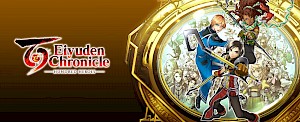VC Weekly 367

Posted 16 Jan 2016 at 17:13 by Sam C Gittins
Welcome to VC Weekly, N-Europe’s guide to the wonderful world of Nintendo’s download service. Written by Sam C Gittins and Dean Anderson.
It's a wonder Nintendo decided to rush out the latest game in the Mario Tennis series on the Wii U as many fans were not impressed with it, least of all our very own Dean Anderson who has reviewed the very best game in the series in this edition which goes some way to demonstrating why sometimes you just can't beat the originals.
There's also a decent insight into New Super Mario Bros. perhaps one of the most underated examples from within the Mario universe, I've always rather enjoyed it personally especially back in the day. Finally we also have the obscure Onimusha Tactics which I had almost completely forgotten existed until it was recently re-released, it's a good thing that it's available to a wider audience now though as I found it to be a pleasant surprise. Anyway enough from us and on with the games!
Available for download this week we have...
Mario Tennis
New Super Mario Bros.
Onimusha Tactics

Publisher: Nintendo
Developer: Camelot
Released: 2000
System: N64
Author: Dean Anderson
Like his golfing endeavours, tennis is a sport that is very familiar to the plumber. From his early days as an umpire in Tennis for the NES, to his virtual reality outing on the Virtual Boy, Mario is no stranger to the court. But like his golfing counterpart series, his N64 tennis outing marked the true beginning of the series we now know and love. Camelot’s Mario Tennis for the N64 was where the foundations for the series as we know it today were laid. From the basic physics engine, to the large variety of modes on offer (ahem, in most Mario Tennis games at least...), to the musical stylings of Motoi Sakuraba, to the basic structure that (almost) all Mario Tennis games since have followed.
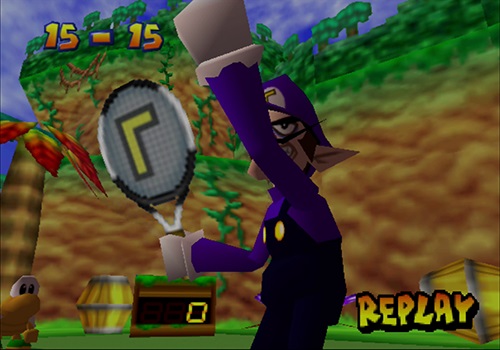
And all good spinoffs have followed this one with the debut of everyone’s favourite cheater (Sorry Dick Dastardly!)
And what a start it is! 16 years on and this is still a regular multiplayer mainstay amongst me and my friends. Camelot nailed a service ace on their first serve here! The game feels amazingly good to play, the physics feel just right, with satisfying visual impact and sound design that belies the dated, yet oddly charming, look of those chunky N64 models and the gameplay is as deep as Mario’s nose is large.
Like all great pick-up-and-play multiplayer games, the gameplay is dead simple to understand and difficult to master. Only three buttons are used here, with topspin (helpfully coloured red) performed with A, a slice shot (helpfully coloured blue) conducted with B and you can cancel a charge shot (oh, did I mention that if you press the button early, you can power up your next shot at the cost of movement speed? If only Ultra Smash got the memo…) by pressing the Z button. You can also perform lob shots by pressing A, then B as well as slow drop shots by pressing B, then A. Finally you have the mighty overhead Smash Shot (given a purple hue) that is performed by pressing A and B simultaneously when the ball is coming from above you. See? Not hard to follow at all! No doubt you’re already feeling like you’ve mastered the game!
Well it’s a good thing that you’re feeling confident, because this game isn’t an easy one… The AI is smart and actually acts differently depending on the character it is controlling; always keen on taking advantage of each character’s unique attributes, such as Power characters (DK, Bowser, Wario) who are slow but (congrats, you guessed right!) very powerful or more unique characters such as Paratroopa, who can fly and reach higher shots more easily. You’re really going to have to plumb this game’s depths and master the physics to triumph in the later tournaments as the AI does not let up.
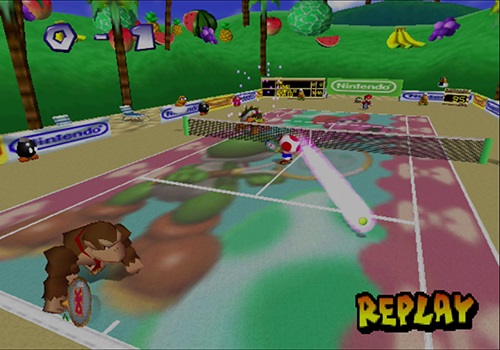
Poor DK never stood a chance…
And you’ll want to play through the main tournament mode with each character as you’ll go on to unlock extra courts (well isn’t that nice! Worthwhile unlockables for playing through a meaty single player tournament mode…) as well as Star variations of each character who hit harder than before and who even get their own special tournaments to play in, which offer an even greater challenge that will test even the most battle hardened of Mario Tennis enthusiast!
But the extras don’t stop there, oh no… You also have the special Bowser Stage which comes complete with items from the Mario Kart series that will help you and hinder your opponents. This makes for a nice, welcome change of pace when you want a break from classic tennis action in favour of something a bit crazier and more chaotic, especially when the court starts tilting as you move!
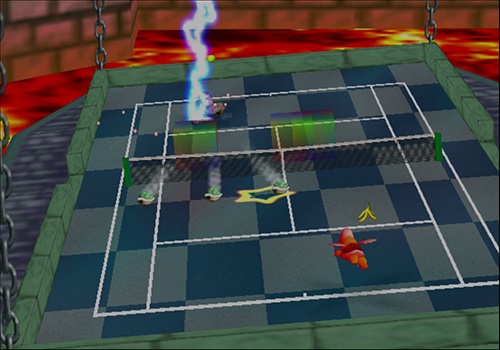
Gimmick stages that make HD Tennis games green with envy!
On top of that, you also have the Piranha Plant Challenge and the old series stalwart mode, Ring Shot. The former pits you against a set of rabid Piranha Plants that launch balls your way, where you have to return the ball past your opponent (good luck trying to hit all 50! You get another surprise if you do though… That’s what we all love about the Camelot Mario Sports games, the love and care that goes into each of them and the many surprises that they hold to be found…), while the latter takes the mode from Mario Golf and puts a new (top)spin on the game. Now you have to hit a certain number of rings within the time limit to clear each stage; this also comes with four different variations with their own sets of stages and each character has their records kept separately, encouraging you to triumph with each of the game’s 16 characters. Both modes can be played in single or multiplayer and yes, the multiplayer records for Ring Shot are indeed recorded separately, giving the game even more replay value (imagine that! A Mario Tennis game with globs of replay value…)
There are 18 courts in all, each with their own unique music and stadiums to go along with them in addition to having various properties, such as faster ball speed and higher or lower ball bounce. However, it must be noted that on Wii U, sadly 6 of them are permanently inaccessible as they were previously unlocked by using the Transfer Pak to link the N64 and the GBC Mario Tennis games. As Nintendo has failed to incorporate Transfer Pak compatibility here (and there’s no way to utilise modified save files like you could on Wii; where modified save files that have the extra 6 courses unlocked are available) those 6 courts are forever lost to time and it’s a shame because those courts featured some of the crazier physics properties (the Waluigi court in particular is one of them and also one of my favourites, with its Fastest ball speed and Strongest bounce properties always being a fitting recipe for mayhem). On the plus side however, the Ring Tournament mode has been re-instated here on Wii U after a mysterious absence on Wii. This mode has you input special passwords to generate various Ring Shot matches with specific characters rules and time limits in place and was originally used to generate codes that you would input on the Mario Tennis website; whereby your high scores could be taken to a world stage, in an early form of rudimentary online leaderboards. While the website has been consigned to the annals of history since 2004, Miiverse support now provides a means of sharing your high scores and so, Ring Tournament now has rudimentary online leaderboards once again in the form of Miiverse screenshots (so get on there and give me a challenge to beat!)
The music is ever so memorable, with the tunes sure to stick with you for years to come and the visuals, as mentioned before, are obviously dated but have a rather oddly charming look about them that only a heart of pure stone could hate (Boo’s polygonal model, I’ve always felt, looks particularly hilarious). For the console it was running on originally, they were top tier and the visuals are still bright (well, as bright as N64 games can get), clean and colourful today; especially when running in high res on Wii U. With lots of lovely little touches scattered around, from the charmingly animated intro, to the bobombs that explode when your shot hits just shy out of the court, this is a lovingly crafted game that shows what can be done when ample time is given for development. The game also runs relatively smoothly, though is no stranger to chugging when things get a bit hectic (and that slowdown is replicated extremely faithfully on Wii U, moreso than on Wii), but most importantly, the Wii U VC version is indeed the US 60hz version, making it a must have for any fan of retro tennis action; if you own the game via the Wii menu, make that upgrade right now!
Overall, this is still one of the greatest tennis games ever made, the best tennis game available on a current generation console and one of the best local multiplayer games of all time. The proof? I still return to it on a regular basis, 16 whole years after its initial release; and if you want proof of that; please enjoy some footage of a few matches between me and a friend of mine recorded from the Wii U VC version (it’s nail-biting stuff! With mind games that would make even competitive Smash Bros blush)
I’m pretty sure that even after another 16 years, I’ll still be returning to this gem and its excellent Gamecube and 3DS sequels for more. You should be too!

Publisher: Nintendo
Developer: Nintendo EAD
Released: 2006
System: DS
Author: Dean Anderson
14 years is a long time! Long had the future been deemed to be three dimensional, with 2D being seen as old hat… that is until 2D Mario finally donned a new hat with the announcement of the Nintendo DS back in 2004.
With nothing but a rather ropey looking teaser video, the imaginations of millions were captured on the spot. The mere idea of a brand new 2D side scrolling Super Mario Bros game alone was enough to stir excitement for Nintendo’s brand new dual screened handheld; what kinds of ideas could modern hardware bring to the table!? What crazy level designs, kooky concepts, weird characters and barmy gameplay features could the revival of 2D Mario herald? One of those would actually seem to be simultaneous co-op multiplayer!
Bizarrely enough though, despite it seeming like a key focus throughout development, the co-op mode was dropped entirely and the final version would only end up having a small, 5 stage race mode. In fact, there’s a ton of stuff that ended up either being changed or dropped entirely, such as the ability to punch and kick like in Super Mario 64 and the ability to hold 3 reserve items at once. Actually, after reading this review, you should just go ahead and read up on the Beta versions of this game and peruse through all the bits that didn’t make the cut; it makes for a fascinating read!
So anyway, how did the final version turn out? Did it live up to the absolutely mammoth expectations it held as the first new Super Mario Bros game in over 14 years? Well…
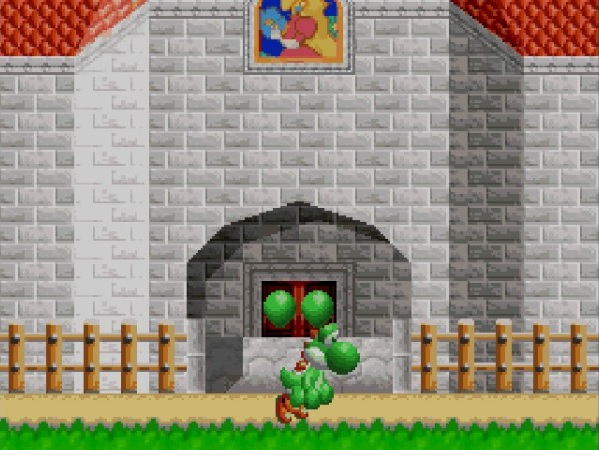
In case it wasn’t obvious from the onset, NSMB is heavily influenced by the then recently released Super Mario 64 DS.
… the short answer is no and the long answer is still no. The even longer answer however is no with a dash of actually, yeah it kinda did.
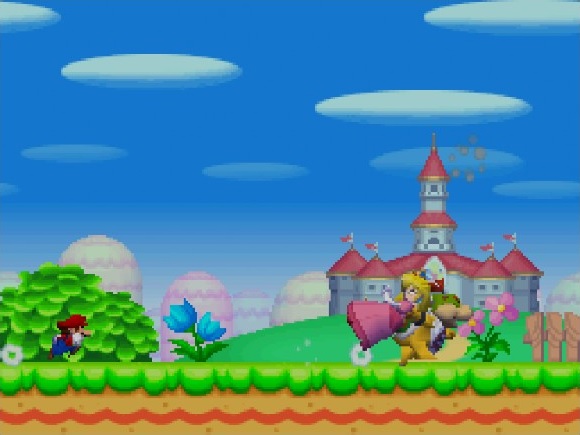
Though Super Mario Sunshine gets more than a few nods throughout as well…
There’s no getting around it, this is a very easy game, in fact it’s without a doubt the easiest game in the entire Super Mario series and that’s an issue that many veteran Mario players would go on to lambast the game for; even when accounting for the three hidden star coins scattered throughout each level that encourage exploration and risk taking to acquire (a level design technique that would go on to inspire most Super Mario games ever since), the game still lacks challenge for those that seek it.
But is that really such a bad thing? While it may not demand much in terms of player skill, it does actually do a great job of introducing new players into the world of side scrolling platformers and for that, it should be commended. However, the simplicity does not just extend to the overall difficulty but also to the level designs which are rather pedestrian in comparison to earlier games in the series as well as its three successors on the Wii, 3DS and Wii U. The levels are all very short and very rarely will you encounter a level which scrolls both horizontally and vertically, making for stages that feel rather cramped and hollow; lacking the depth that make the stages in other Mario games so memorable and well loved.
But it sounds like I’m just ragging on at it (and to some extent, I am), so it’s only right that we note the good. To this day, I still feel that it was the right decision to remove flight. It was a brave decision to eschew the feather and super leaf powerups that everyone loved so much from Super Mario Bros 3 and Super Mario World but I feel it was the right decision to take as it pushes the gameplay focus on pure platforming; something that this game does, and its successors especially do, very well. The controls feel tight and responsive, but Mario doesn’t turn on a dime like how he does in Super Mario World; instead, the physics take a cue from the first game and momentum plays a starring role. You have to predict how long Mario is going to take to turn in mid-air and how long he’s going to take to turn around and this in turn makes for a more engaging platforming experience that punishes you for your mistakes and asks you to think before you leap.
In terms of new powerups though, this outing sadly disappoints. With the mini Mushroom basically acting as a key to unlock hidden paths to secret levels and the Mega Mushroom being nothing more than a demonstration of the DS’ then impressive graphical capabilities, only Shell Mario remains as a significant new powerup and that comes with very limited use throughout the game. Though fun to use, it’s not hard to see why it never returned for the sequels (though it did get a cameo appearance in Super Mario 3D World). Where it does not disappoint however is in Mario’s enhanced moveset. Following in the wake of Super Mario 64 DS, Mario now comes equipped with a Ground Pound, a Wall Jump, the ability to hang and climb on railings, the ability to walk across tightropes (there’s another nod to Super Mario Sunshine!), hang off ledges and double and even triple jump! Phew! That’s a lotta moves! This is a game that feels good to play, even when the level design doesn’t really call for much of his full moveset, so even though the game features rather dull and simplistic level design, it is still a Super Mario Bros game and as such, it feels as good to play as you’d expect.
And while many people are quick to deride the NSMB series as derivative, they aren’t as quick to acknowledge the gameplay features and level gimmicks that are unique to each game. So I will be quick about here in this short review as, despite what many would say, this game does bring much new to the table, be it rotating platforms, pipe cannons, growing, shrinking and bounceable mushrooms or even the koopas famously dancing to the BAHS of the music, this game does indeed feature its fair share of surprises and unique gameplay gimmicks along the way, a surprising amount that never feature in any subsequent NSMB game at that!
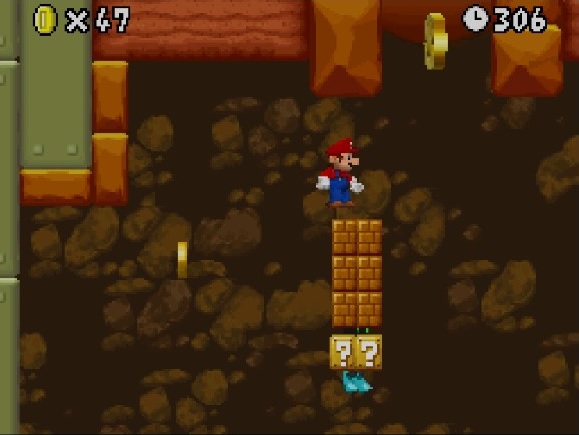
Though the level designs are generally fairly pedestrian, the game certainly has its clever moments…
A special shoutout should go to the bosses throughout the game as well. This was the first Mario game to have unique boss encounters at the end of every world and they actually stand as some of the most interesting in the series (Dry Bowser’s debut also came as quite the surprise, who would’ve thought that he would take after Crocomire!)
On top of that you also have a selection of minigames that are mostly taken from Super Mario 64 DS. While these are a nice extra and some will likely have you coming back to them for more, they really especially shone in multiplayer; something that was added to them from their first outing in Super Mario 64 DS. Tragically however, the multiplayer features are unavailable on Wii U and so, their inclusion is pointless here if you already own Super Mario 64 DS on Wii U (which has a larger selection of minigames). If you don’t already have it though, chances are that you will end up spending a lot more time with them than you’d first think (especially Bob-omb Squad and Sort or 'Splode – I used to have the top score in NOM for the latter back in the day! Ahh, the days before online leaderboards and Miiverse… Good thing you have the latter now!) Likewise the surprisingly engaging Mario VS Luigi multiplayer mode is also sadly inaccessible, forever taunting you on the title screen for all eternity… (Seriously Nintendo! Come on! Fix this already!)
On the visual front, you have probably already made your judgement on the series as a whole. The visuals strictly follow function over form and aim to make the gameplay as clear as possible; they do the job and that’s about it. Here on Wii U however, some of the strings tend to show though as it becomes rather clear as to what game characters/objects are pologonal and which are pre-rendered sprites, making for a rather jarring contrast that was better disguised on the DS’ small screens… You learn to look past that quick enough, but if you’re not a fan of the series look, you’re especially not going to like how it looks here on Wii U. As for the music, I am not a fan of this one outside of the main theme (which would feature in each subsequent NSMB game) and the really quite catchy Mario VS Luigi theme (but of course, you’re not gonna hear that here on Wii U anyway…)
Overall, this game accomplished what it set out to do rather admirably. It re-introduced the world to 2D Mario and did a fantastic job of introducing newcomers to 2D platforming in general. It is the quintessential My First Mario Game and while long-time fans may be disappointed by its more pedestrian nature, I bet that this would be the first Mario game that they’d give to their loved ones to try the series for the first time…

Publisher: Capcom
Developer: Capcom
Released: 2003
System: GBA
Author: Sam Gittins
As a franchise Onimusha has always been of interest to me even though I'm not terribly well-versed in any of the games, it appears to have an interesting conceptual stage it went through when Capcom were attempting to make it into a Ninja version of Resident Evil in the early Playstation era, as time went by with the original game moving to the Playstation 2 it soon become the Samurai-centred series which many multiformat gamers will undoubtedly be familiar with. Spare a thought for Nintendo only gamers then for when Onimusha Tactics arrived two years later out of the blue - perhaps coincidentally two months after a certain tactical Final Fantasy game arrived for the GBA - as it will surely have seemed like a bolt from the blue; indeed it seems that this entry is certainly not considered to be canonical yet it does pick characters from various games in the series plus it does have a similar plot which is that a samurai who possesses the Oni Gauntlet can become the Onimusha who fights against Nobunaga and his army of genma. Right, well that's that sorted then, on with the tactical enemy-slaying action!
Just like with the Fire Emblem series this is a Strategy Role Playing Game yet here you do not have to suffer the fate of your characters permanently dying if they fall in battle, indeed it's probably best compared to Final Fantasy Tactics yet even then this still isn't quite accurate as it's nowhere near as in-depth as either of those series; in this case it proves to be a good thing as Onimusha Tactics in turn is far easier to get into than its peers who suddenly become just that much more daunting in comparison. Assuming an isometric perspective - pioneered by Ultimate Play The Game in the Eighties - with a top-down view which gives you an unparalleled amount of scope, you must move your characters across a grid but only after choosing which pieces of equipment is to be assigned to each party member in your five-strong team, it gets interesting here as you have two slots which each character has for items which isn't a lot so it tends to bring about a cautious way of playing especially if you have limited amounts of healing items with no other easy way of recovering health in the heat of a battle.
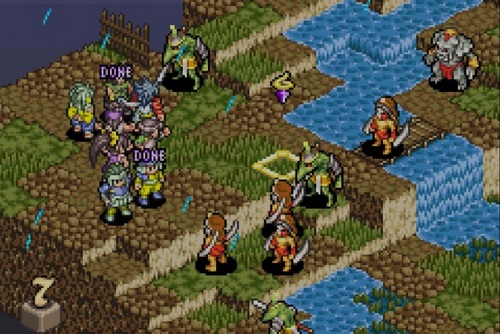
The top-down isometric viewpoint in all its glory...
So although the rules of combat aren't as stringent as in other examples in the genre, you'll still need to be cautious if you want to make it through each battle as some of those Genma demons can be rather fierce; you will probably find yourself crafting items in order to give you the combative edge as you make new equipment and then you can also fortify them further through the use of souls stripped from some of the many Genma you will slay in your quest for revenge being that the main character's - Onimaru along with his sister Oboro from the Oni Clan - village was burnt to the ground... well you've got to have that box in the plot ticked at the very least, it's good to have a reason for the fighting plus the story is actually rather enjoyable despite its repetitive themes. This title plays rather comfortable on the gamepad and although you may have to use the D-pad as opposed to perhaps instinctively reaching out for that touch-screen, the controls really simple and intuitive which helps things along nicely.
There's a decent level of detail afforded by the isometric perspective which really makes the battle scenes stand out as the best part of the game, though the presentation throughout isn't bad at all seemingly staying faithful to the era in which it's set; there are plenty of decent animations too while the menus are plain yet functional. All of the Sound is of decent quality featuring a solid soundtrack which borrows from better examples within the genre, so at times it can feel like a "best of Strategy RPG" soundtrack except not quite as good but with its own unique style; the overall sound quality is very good though and features some substantial sound effects to boot even if they can seem a little over the top at the best of times.
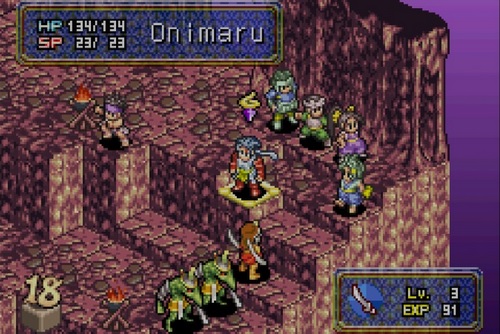
...it's a technique taken for granted these days but it deserves more credit.
Onimusha Tactics is well worth investing in if you like the genre as it's quite unlike any other SRPG on the market even though it's clear to see where it gets the majority of its ideas from, the few things it does different in the name of creating an experience which is more open than its contemporaries certainly works to its advantage. Anyone who has perhaps become daunted by the prospect of such a genre in the past may well fine their ideal starting point right here and though it might sound like disservice, if this relatively unassuming game gets people who have never played a Strategy Role Playing Game in their lives to try this and then go on to play a title or two in the Fire Emblem series then all the better! As it stands though, we have here a very competent title which will entertain even advanced players for a few sessions and even longer for those who are new to the genre, never before has there been a better time to at least try out different games.
That's it for another installment of VC Weekly which will return again soon. So until then, enjoy the rest of the week and Game On!

